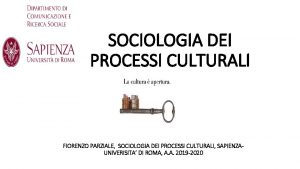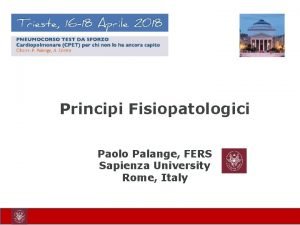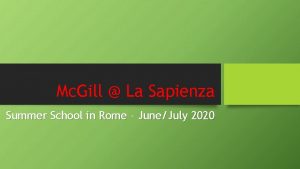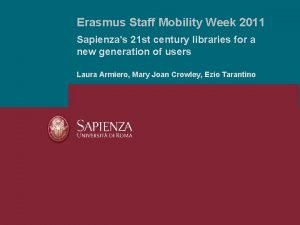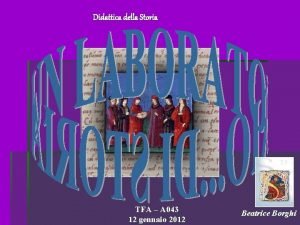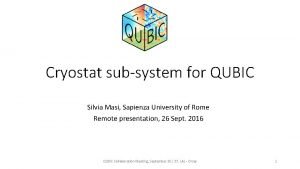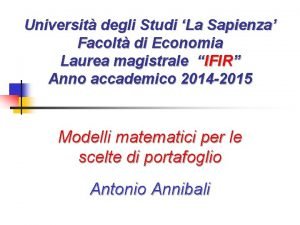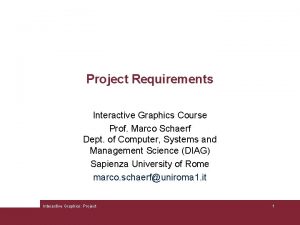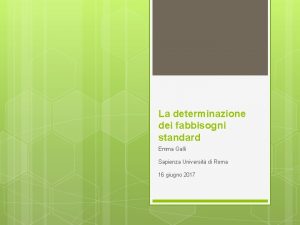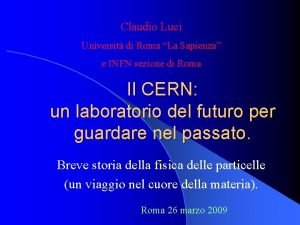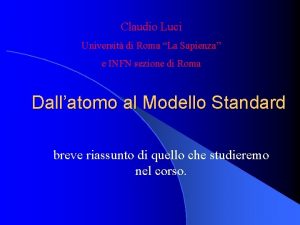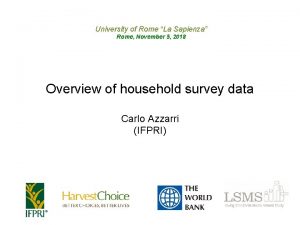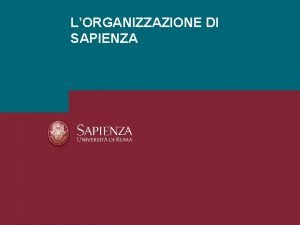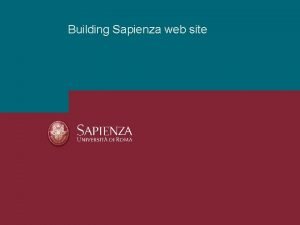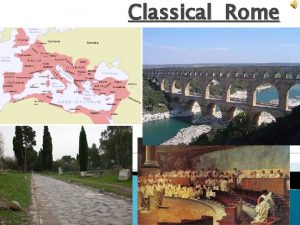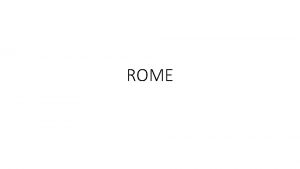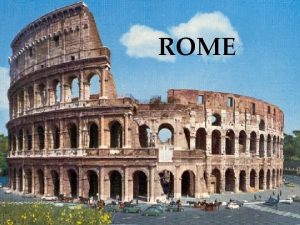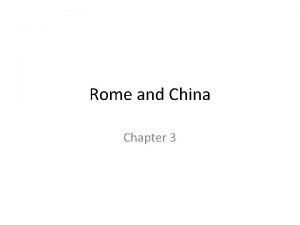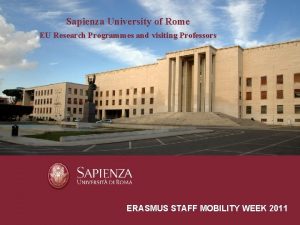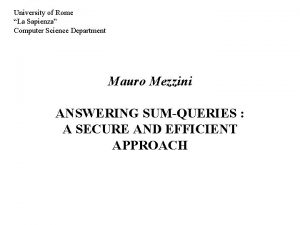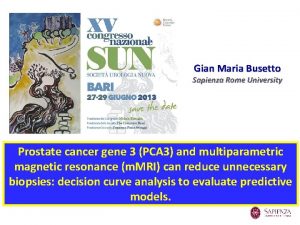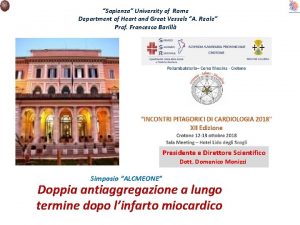University of Rome La Sapienza Centro Ricerca Progetto



















- Slides: 19

University of Rome “La Sapienza” Centro Ricerca Progetto San Marco - CRPSM, Italy The Development of a Fire Vulnerability Index for the Mediterranean Region G. Laneve, M. Jahjah, F. Ferrucci 1, F. Batazza 2 Munzer JAHJAH munzer. jahjah@uniroma 1. it University of Rome “La Sapienza” 1 Università della Calabria, Department of Earth Sciences, Rends (CS), Italy 2 Agenzia Spaziale Italiana, Rome, Italia 2011 IEEE International Geoscience and Remote Sensing Symposium

Ø Outline Ø Objectives Ø SIGRI, Fire risk indices Ø Data specification Ø Methodology Ø Results Ø Conclusion 2011 IEEE International Geoscience and Remote Sensing Symposium

Ø Objectives 1 To develop a daily Fire Risk Index with the objective of showing the total risk level for the area of interest and the zones of major concern within such area. 2 To develop maps able to show the fire risk considering the tight relationship between fire and: • fuel characteristics (vegetation type, density, humidity content); • topography (slope, altitude, solar aspect angle); • meteorological conditions (rainfall, wind direction and speed, air humidity, surface and air temperature). 3 Comparing the daily computed indices with the fire distribution obtained by using a fire detection algorithm based on SEVIRI/MSG images. 2011 IEEE International Geoscience and Remote Sensing Symposium

Ø SIGRI, Fire Risk Indices ‘ 1’ The SIGRI pilot project, funded by ASI, aims at developing an Integrated System for the Management of the Wild Fire Events. The system should provide satellite based products capable to help fire contrasting activities during all phases: prevision, detection, and damage assessment/recovering. The fact that 90% of fires is of human origin does not diminish the interest of the fire risk index, which however gives an assessment of the possibility of its spread and possible associated risks. 2011 IEEE International Geoscience and Remote Sensing Symposium

Ø SIGRI, Fire risk Indices ‘ 2’ Methods to estimate fire risk 1 - Statistical or Structural (long-term fire risk index) Methods defining forecast models based on the utilization of slowly changing parameters, like topography or other variables that can be considered constant along the year and statistical information on the frequency of the phenomenon. 2 - Dynamical Methods (short-term fire risk index) based on data measured continuously (i. e. daily), on characteristics territorial data (orography and vegetation) and on forecast models of the meteorological parameters 2011 IEEE International Geoscience and Remote Sensing Symposium

Ø SIGRI, Fire risk Indices ‘ 3’ The short-term fire indices are able to provide information on the danger of the event defining: areas of possible ignition, propagation direction and speed, irradiated energy, etc. This index represents: Ignition probability Forest fire propagation Daily level of risk definition By combining this daily fire risk index with that information typical of the Likely Probability Index (infrastructures, protected areas, etc. ), we can compute the Fire Vulnerability Index that would be one of the products provided by the SIGRI project. 2011 IEEE International Geoscience and Remote Sensing Symposium

Ø Methodology ‘ 1’ FPI Burgan 1998 Extinction moisture Died vegetation FPI Burgan 2000 Relative greenness JRC To take into account the effect of solar illumination in determining the existing humidity in the died vegetation Evapotranspiration On going activity Changes in water content in plants tissues have a large effect on leave reflectance To improve the performance in the Mediterranean area Vegetation water content 2011 IEEE International Geoscience and Remote Sensing Symposium

Ø Methodology ‘ 2’ 16/16 20/18 11/12 9/10 17/19 19/20 15/15 7/7 6/12 14/14 18/11 5/8 13/6 11/13 4/4 1/3 8/5 10/9 2/2 3/1 2011 IEEE International Geoscience and Remote Sensing Symposium

Ø Methodology ‘ 3’ Daily NDVI 2006 2010 NDVI 16 days Min (7/8) Min RG Max (3/4) Evapotranspiration Relative greenness Max Fuel Different fuel type have different fuel loads, we have 12 categories (Calabria). Different LL typechosen according Green veg. fraction weight factors were to live. LLFM and dead fuelveg. loads for each fuel to type Green fraction linked fuel type Corine DL Dead DLFM Fuel veg. fraction Dead veg. fraction. FPI linked to fuel type Min MX Min humidity MXD Dead veg. ext. moisture hum Fire prob. FM is a very important parameter for FPI, representative for MC. FM was calculated index Empirically considering three intervals: H <10, 50> H>10, H >50 Temp/humid EMC FM TNF Ten hour lag fuel moisture Fraction of ten hour lag fuels moisture 2011 IEEE International Geoscience and Remote Sensing Symposium

Ø Methodology ‘ 4’ On going activity Hargreaves Thornthwaite Penman-Monteith duration of the illumination time of the average elevation Day/30’’ Sun declination Aspect DEM Local sun elevation Slope Sun elev. at H / sun Az Sunset local time Potential sunshine Period x day Y/m/15 d T&H Solar incident Radiation Solar radiation TOA Evapotranspiration 2011 IEEE International Geoscience and Remote Sensing Symposium

Ø Methodology ‘ 5’ Risk map 1 1=0 -20 2=20 -40 3=40 -50 4=50 -65 5 >65 Risk map 2 Av of ET 4 Std 4 of ET Std 5 of ET Av of ET 5 IF Risk map 1= 4 AND ET >Av+std 4 Class 4 =class 4 +1 IF Risk map 1= 5 AND ET >Av+std 5 Class 5 =class 5 +1 Differences= Risk map 1 - Risk map 2 - value + values 2011 IEEE International Geoscience and Remote Sensing Symposium

Ø Results ‘ 1’ July 2011 IEEE International Geoscience and Remote Sensing Symposium

Ø Results ‘ 2’ 2011 IEEE International Geoscience and Remote Sensing Symposium

Ø Results ‘ 3’ 2011 IEEE International Geoscience and Remote Sensing Symposium

Ø Results ‘ 4’ pre post 2011 IEEE International Geoscience and Remote Sensing Symposium

Ø Results ‘ 5’ Performance of pixels with value FPI= 5 Performance of pixels with value FPI= 4 140 40000 140 120 35000 120 100 30000 100 25000 80 20000 60 15000 40 10000 20 80 Series 1 Fires 60 Series 2 FPI= 5 40 20 5000 0 30000 25000 100 20000 80 60 40 15000 Series 1 Fires 10000 Series 2 FPI= 4 5000 20 0 0 1 3 5 7 9 1113151719212325272931 Series 2 FPI= 4 Performance of pixels with value FPI= 2 Performance of pixels with value FPI= 3 120 Series 1 Fires 1 3 5 7 9 1113151719212325272931 140 40000 35000 30000 25000 20000 15000 10000 5000 0 140 120 100 80 60 40 20 0 60000 50000 40000 30000 Series 1 Fires 20000 FPI= 2 Series 2 10000 0 1 3 5 7 9 1113151719212325272931 FPI=5 give an indication on the effective risk of fires in the area 2011 IEEE International Geoscience and Remote Sensing Symposium

Ø Conclusion ‘ 1’ 1 - The FPI was computed using the three methods (Burgan 2000 was adopted). The index was tested in the Calabria Region using fire hot spot which were obtained by SFIDE algorithm; 2 - The FPI index was improved by introducing the Evapotranspiration parameter; 2011 IEEE International Geoscience and Remote Sensing Symposium

Ø Conclusion ‘ 2’ 3 - The FPI index range < 30, as expected, shows no correlation with the number of hotspots, while FPI > 55 clearly increases with the increase of the fire occurrences; 4 - The objective is to compute the FPI index for 5 years (2006 -2010) in order to evaluate the performance including other parameters like EWT; 2011 IEEE International Geoscience and Remote Sensing Symposium

Ø Questions & Comments 2011 IEEE International Geoscience and Remote Sensing Symposium
 Erba sacra roma
Erba sacra roma Centro zonal norte centro historico
Centro zonal norte centro historico Centro escolar university address
Centro escolar university address Sociologia dei processi culturali sapienza
Sociologia dei processi culturali sapienza Paolo palange sapienza
Paolo palange sapienza La sapienza summer school
La sapienza summer school Erica antonini
Erica antonini Bixy sapienza
Bixy sapienza Tiziana de matteis sapienza
Tiziana de matteis sapienza Didattica della storia sapienza
Didattica della storia sapienza Silvia masi sapienza
Silvia masi sapienza Uweb sapienza
Uweb sapienza Versace
Versace Wolfram alpha sapienza
Wolfram alpha sapienza Interactive graphics sapienza
Interactive graphics sapienza Emma galli sapienza
Emma galli sapienza Adalberto sciubba
Adalberto sciubba Luci sapienza
Luci sapienza Luci sapienza
Luci sapienza Proemio de rerum natura
Proemio de rerum natura



